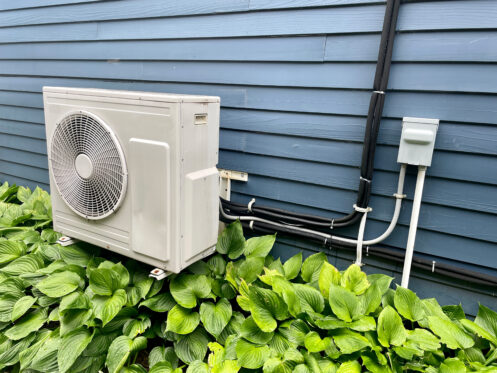Heat pumps are quickly becoming one of the most popular HVAC options in California. This is partly because they’re highly efficient and also because the U.S. Federal Government and the State of California currently offer tax credits, rebates and other incentives to encourage people to install heat pumps in their homes. Heat pumps are potentially the least expensive heating option in warmer climates like California. Another thing that makes them unique is that they’re the only type of HVAC system that can provide air conditioning as well as heating.
Central vs. Ductless Heat Pumps
In terms of whether heat pumps provide central air, it depends on what type of system you’re looking at. A central heat pump indeed provides central air. That means it cools the warm air coming into the central HVAC system and then blows cold air out around the home.
There are also ductless heat pump systems, also known as ductless mini-splits. Ductless systems work differently and cool each part of a home or room independently. A central HVAC system has one large air handler that draws in warm air, cools it and then circulates the cold air around the house. Some ductless heat pump systems also have only one air handler. The difference is that the air handler in this type of system just draws warm air in from the surrounding area and then blows the cool air directly back out into the room it’s in. More commonly, there are multi-zone ductless systems that have from two up to eight air handlers. This type of system works no differently from a single-zone system since each air handler just cools the room or space it is in. As with any type of heat pump, a ductless system can also be switched over to provide heating in the winter.
How Heat Pumps Provide Air Conditioning
When in cooling mode, a heat pump functions the same as any other type of air conditioning. That means that it works by absorbing heat from within the building to decrease the air temperature and then transfers the heat outside the building. Heat pumps and other air conditioners do this by using refrigerant. Refrigerant is a special type of chemical compound that has unique properties. Namely, it starts boiling at an extremely low temperature (around -15 to -22 degrees for most refrigerants). This allows it to get extremely cold without ever freezing.
Heat transfer occurs naturally due to heat energy always moving from a higher temperature object or substance into any cooler objects or substances. All air conditioning systems have an evaporator coil that the cold refrigerant continually gets pumped through. When the warm air the fan pulls in hits this coil, much of the heat it contains flows out and gets absorbed by the refrigerant. This again happens because the refrigerant is so much colder than the refrigerant.
The refrigerant starts to boil once it absorbs enough heat to reach its boiling point, which results in it changing states from a liquid to a gas. The gas then gets pumped back to the heat pump (or AC), where it gets compressed. This process causes its pressure to massively increase, which instantly causes its temperature to rise to 120-140 degrees. Since the refrigerant becomes so hot, most of the heat is removed from the building and flows into the air outside as the refrigerant gets pumped through the condenser coil. The final step is to pump the refrigerant through an expansion valve so that the pressure decreases again and it cools back down to below its boiling point.
Differences Between Heat Pumps and Standard Air Conditioners
Technically speaking, there is only one difference between a heat pump and any other type of air conditioning system. The difference is that a heat pump has one additional component, known as a reversing valve. In any other type of air conditioning, the refrigerant can only flow in one direction. That means the compressor pumps the cold refrigerant inside and then the hot refrigerant flows back outside. The reversing valve in a central or ductless heat pump system enables the refrigerant to flow in either direction so that the heat pump can both cool and heat.
When you switch a heat pump from cooling mode to heating mode, the first thing that happens is that the system activates the reversing valve. That means that instead of removing heat from inside the house and transferring it outside, the system starts absorbing heat from outside and releasing it inside to heat the house. The reason that this can work is that there is always at least a small amount of heat in the air outside, no matter how cold it is. The only time it can’t work is if the temperature outside drops below the refrigerant’s boiling point. That means most heat pumps can produce at least some heat until the outdoor temperature drops to around -15 to -22.
Why Heat Pumps Are Ideal for the California Climate
One factor that is driving so many people to install central or ductless heat pumps is that they are so cost-effective. You will have to pay a bit more up front for a heat pump than you would if you chose to install a standard air conditioner. Nonetheless, the overall cost will likely be less than you’d pay for an air conditioner and a separate heating unit. Your heating costs will also usually be far lower with a heat pump than they would with any of the other heating options.
Directly comparing the costs of a standard air conditioner and a heat pump also doesn’t tell the full story. That’s because a high-efficiency heat pump qualifies you for a federal tax credit of up to $2,000, whereas a highly efficient AC is only eligible for a credit of up to $600. California also offers a $1,000 statewide rebate on new heat pumps, and most local utility companies offer additional rebates as well.
One reason why heat pumps are perfect for California is that you typically won’t ever need to worry about it being too cold for the heat pump to heat your house. This can be an issue in cold climates, which is why heat pump systems in cold climates often come with some form of backup or supplementary heating.
One final thing to note is that heat pumps cool just as effectively and work just as efficiently as standard air conditioners. That means you won’t need to worry about any issues with the heat pump not keeping your home cool or your energy bills being any higher than they would be with a standard AC.
If you’re considering a heat pump for your home in the Vacaville area, you can turn to the experienced professionals at Cozy Home Services for help. We offer a range of quality, efficient central and ductless heat pumps and will work with you to help you choose the right option. We also install central and ductless air conditioners as well as furnaces, and we offer financing for all new units on approved credit. We take pride in going the extra mile for our customers, and you can count on us to provide an unmatched level of service and support no matter what HVAC or plumbing service you need. If you have any questions or want to learn more about your options for a new heat pump, contact us today.


